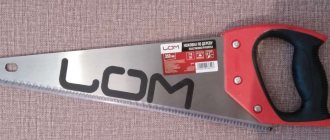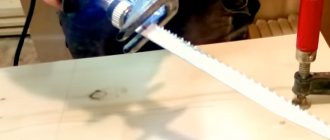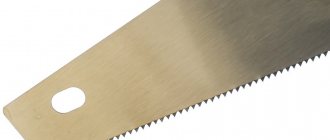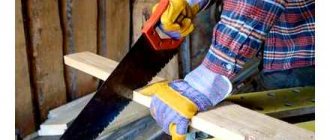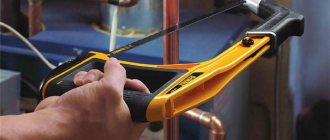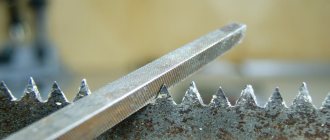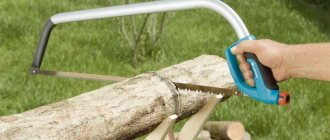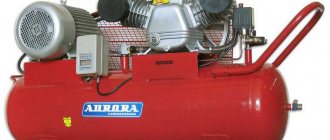It is difficult to imagine the arsenal of tools of a home craftsman or mechanic without a hand saw. Another name for it is a hacksaw. With this tool you can cut down branches in the garden, shorten pickets for a fence and do a lot of other work where you need to change the length of a wooden product: laminate flooring, farm boards, etc.
You may not have thought about it, but the correct choice of a hacksaw determines not only its service life, but also the ease of use and quality of the cut. Let's consider the main parameters of the correct choice of this tool, which is necessary for household and carpentry activities.
Canvas size
Depending on your task, you can choose different blade lengths. For simple boards and small bars, a length from twenty-eight to thirty centimeters is quite suitable. If construction work is underway, then it would be wiser to take a canvas from forty-five to fifty centimeters long.
The basic rule: the length of the product should be half the length of the hacksaw itself, otherwise you can forget about ease of use.
Types of electric and gasoline saws
Gasoline and electric tools have a motor or motor that rotates the tool. Thanks to this, the operator has to put in less effort and the work speed increases. Some versions of the tool are self-contained and suitable for field conditions, others are corded and require a 220 V outlet. Here are the main features of this category of saws.
Chainsaw
The saw operates with an internal combustion engine. Requires gasoline and lubrication of the small cutting part. The tool varies in bar length, which ranges from 35 to 60 inches. This affects the ability to cut a certain diameter of the trunk in one approach from one side.
Device
The cutting element is a chain consisting of links and protruding teeth. It is looped and moves along an oval bus with a guide. The operator holds the unit by the main and auxiliary handles. You can cut horizontally or vertically.
Replacement and tightening of the chain is carried out by a tensioning mechanism on the side. If the working part gets caught in the material, the saw will bounce off. To increase safety, it is equipped with a chain brake that is activated when the plastic safety stop collides with the operator’s hand.
Chainsaw.
Purpose
The presence of exhaust gases allows this type of tool to be used only outdoors. Chainsaws are often used for felling trees and collecting firewood. Thanks to the autonomy of the gasoline engine, they are suitable for long-term use in field conditions.
But the tool is quite universal, so it is used almost everywhere:
- construction of houses and baths from logs;
- cutting firewood in the yard of the cottage;
- cutting down garden trees;
- figured cutting of sculptures from concrete or ice.
Thanks to the powerful engine, the saw copes well with dense materials and withstands heavy loads. But this is an expensive tool that requires proper care.
Electric chain saws
They are similar to gasoline ones in terms of the cutting part and use the same chains. But thanks to an electric rather than a gas engine, they have both their advantages and disadvantages. Within their type, they are divided by tire length and power.
Electric chain saw.
Device
The electric motor is located in front of the main handle and is installed longitudinally or transversely. In the first case, the electric saw has a narrow body, and in the second - with a shorter one. This is worth considering when choosing for use in limited space. All corded chain saws are connected to 220 V. There are 36 V battery versions.
Cordless chain saw.
Electric saws are lighter than chainsaws, so they are less tiring on your hands and are suitable for long-term work throughout the day. They do not emit exhaust gases and are used both indoors and outdoors. Their design is also simpler (only an electric motor, gearbox and equipment), which is why they cost less and repairs are inexpensive.
But the presence of a power cord limits the operator’s maneuverability, and sometimes simply gets in the way (when working at height or frequently walking around a large workpiece). Cordless electric saws are not as powerful and are limited in terms of duration of use by the capacity of the battery.
Purpose
In general, this is a universal tool, but the presence of a power cord allows you to use it only close to an outlet. They are used to cut firewood in the yard, build wooden houses, and cut openings for doors and windows in wooden houses.
Reciprocating saw
It got its name because of its curved cutting element, reminiscent of a saber. Among craftsmen it is also called an electric hacksaw.
Reciprocating saw.
Device
It has an electric motor and gearbox that makes the saw blade move back and forth. Due to such repeated translational movements with high frequency, a cut is made. To protect the operator's hands, there is a stop on the second handle next to the equipment. The main handle is L-shaped or D-shaped. Some models have a step speed switch that helps you set the desired speed for a specific material.
The tool is either corded or cordless. The pros and cons of the type of power supply here are the same as with other saws: a corded one limits mobility and requires an outlet nearby, and versions with a battery remain autonomous only for an hour. For longer use without interruption, you will need a second battery. Then the batteries can be alternated, changing them in the tool and charging them in the base.
Cordless reciprocating saw.
Purpose
The main feature of a reciprocating saw is its compactness and light weight. Thanks to this, it is used at heights or in hard-to-reach places where it is inconvenient to operate a chain saw or a hand-held circular saw.
For example, it is well suited for roofing work. The model cuts not only wood. Special replaceable blades allow you to cut stone, concrete, and metal. There are saw blades that can be used to make neat cuts in combined materials.
Saw alligator
It is a type of reciprocating saw but is intended for larger objects and workpieces. It got its name due to the use of two toothed blades, similar to the double dentition of an alligator. The tool can be battery-powered or corded. The first type is much more expensive.
The alligator saw.
Cordless alligator saw.
Device
It has handles on the motor block and a long guide. Two blades move along the bottom of the tire in opposite directions. The stroke length can be up to 40 mm. This ensures an even cut and minimizes the cutting line moving to the side. When the blade becomes dull, it is replaced with a new one.
Purpose
Most often, the alligator saw is used for cutting aerated concrete and building blocks of similar structure and density. It is lightweight and suitable for sawing bricks perpendicularly or diagonally. But two blades in the composition increase the thickness of the cut, which is important to take into account when calculating the size of materials.
Circular (circular) hand saw
It is held with one hand and can be used for cuts in the downward and vertical positions. It is called disc because of the rotation of the disk as the main cutting element. Thanks to this design, it is compact. There are versions powered by 220 V mains and battery-powered 36 V.
A circular saw.
Cordless circular saw.
Device
It consists of a D-shaped single handle, a transverse motor, to the shaft of which a steel disk with teeth is attached. Rotation of the working part at high speed ensures fast cutting of wood. The circular saw blade is protected by a sliding casing that automatically closes the teeth after the saw is removed from the board. The cutting depth depends on the diameter of the disc and can reach 50-60 mm.
Some models are capable of tilting the blade at an angle to make a bevel cut.
Purpose
The circular saw is used for longitudinal and transverse cutting of boards, beams, etc. Due to its low weight and size, it is convenient for working at heights, for example, trimming pediment boards, frames, rafters, etc.
Circular machines (sawing)
It has a similar cutting element as a hand-held circular saw, but is installed on the floor or table. The user, instead of a tool, holds the workpiece itself in his hands, feeding it at the desired angle to the disk. This simplifies the processing of large parts, but this technique is not used at heights. All types of sawing machines are networked.
Device
All circular saws have a motor and a drive (belt) that transmits torque. There must be a support platform with a slot from which the cutting disc looks out.
Structurally, there are three options for the types of circular saw:
1. Tabletop - has short legs and is installed on a workbench or durable table. The weight of the machine is within 20 kg, so after work it can be put away on a rack or other convenient place. A small disk allows you to cut material with a thickness of 40-80 mm.
Tabletop circular saw.
2. Circular sawing machine with stand - equipped with a table extension, on which it is convenient to place boards or timber with a length of 2-3 m. This ensures an even cut and relieves the operator, because he does not need to hold the weight of the workpiece with his hands.
Circular saw with stand.
There are versions with folding legs, so the machine is suitable for easy transport to the workplace. Depending on the diameter of the disc, the cutting depth is possible up to 80-90 mm.
3. Stationary circular saws - designed for operation in one place, since they weigh 40-50 kg. The heavy bed ensures a stable position even when processing large workpieces. It can be equipped with large discs that cut depths from 70 to 125 mm.
Stationary circular machine.
Purpose
Using circular machines, wide boards and beams are unraveled.
Straight transverse and oblique cuts are possible. Small desktop versions are optimal for working in the garage. Machines with stands are suitable for field activities in order to prepare all the wooden parts on site, rather than transporting them to the workshop. Stationary machines are in demand in enterprises and furniture factories.
Miter saw
It got its name from its ability to cut only ends and perform cross cuts. The material is not used for longitudinal dissolution.
Miter saw.
Device
Consists of a base and a lowering disk with teeth. The electric motor is located on top and transmits torque directly to the saw element. There are no belts or chains in the mechanism. The top of the disk is covered with a metal casing. Lowering is carried out on a bracket with a hinge, and the operator holds on to the handle.
The base of the machine has a stop for placing workpieces and securely fixing them. This promotes cutting accuracy. Some types of miter saws are capable of tilting the cutting blade to the left or right relative to the table to produce a miter cut. The mechanism provides for a tilt of up to 45-55 degrees.
One type of these saws is the broach miter saw. The saw blade of such a tool is mounted on special guides and can move horizontally. This design allows you to cut and trim fairly wide workpieces.
Miter saw with broach.
The saw is installed on a table or workbench. The weight of 10-30 kg makes it easy to rearrange it, put it away for storage and transport it to another place of work.
Purpose
The main area of application for trimming is woodworking. With its help, timber and boards are cut to size for subsequent assembly. Miter saws are designed for miter joining parts. If you replace the disk, then using the device you can cut aluminum, plastic and other non-ferrous metals. The machines are used in framing workshops and furniture production.
Cut-off (mounting) saw
As the name suggests, it is designed for quickly making cuts on parts during installation. Essentially, it is a small cutting machine that sits on a table or even on the floor.
Device
Structurally, the saw is similar to a miter saw: there is a bracket on a hinge, a motor on the axis of which the saw blade is mounted, and a base. The machine is located on the table. Weighs 10-15 kg and can be easily moved from place to place by one person.
The difference from a miter saw is the design of the cutting disc. Here an abrasive wheel is used (similar to wheels for angle grinders, only with a larger diameter and thickness) or a steel disk with teeth and pobeditovy tipped.
The base is equipped with a vice for fixing workpieces. To prevent sparks and abrasives from flying into your eyes, a transparent protective screen is provided. Rotating the vice and tilting the wheel expands the cutting line options.
Assembly saw.
Purpose
The assembly saw is used on construction sites for quick cutting of workpieces. The abrasive wheel allows you to work with metal with a thickness of 1-30 mm. The tool is also used in production for the serial production of parts for welding. It is used to cut: profile and round pipes, fittings, rods.
Stationary band saw
It got its name because of the cutting element in the form of a moving saw blade.
Device
Vertical machine with electric motor and roller system. One node is located at the top of the device, and the other at the bottom. Between them there is a frame with a slot on which the workpiece is located. The cutting depth depends on the height of the workplace between the two rollers and the table, but even for the largest stationary machines this figure does not exceed several tens of centimeters.
Stationary band saw.
Purpose
A stationary band saw is used for straight and curved cuts in wood, metal, and plastic. A thin saw blade allows you to cut figuredly and make cuts with complex configurations. This is in demand for decorative elements or when creating special structural blanks.
Band saw
It also uses a saw blade, only the tool is small and convenient for transportation. There are two types of shape.
Device
The portable tabletop version has a rectangular base and the working part with rollers, belt and motor is lowered by pressing the handle. This saw can be easily placed on the table for convenient manipulation of workpieces. The parts are fixed using a vice built into the base.
Portable band table saw.
The hand-held band saw is made without a base - there are two handles above the rounded edges of the body with rollers. The operator holds the tool suspended, and the part to be cut is placed on the table, floor, or clamped with additional vices or clamps. Carrying the device is even easier.
Hand band saw.
Purpose
Band saws are used by welders and plumbers to make complex cuts where a grinder or other tool is not suitable. With its help, work is carried out on metal, plastic and wood. But the compactness affected the maximum possible size in height of the installed workpiece - often it does not exceed 10 cm.
Combination saw
It is called so because of the possibility of combining two cutting methods. They cannot be carried out at the same time - only one by one. This became possible thanks to the complex design.
Combination saw.
Device
The saw has a base and a hinged bracket. An electric motor and a working disk are attached to the latter. Lowering the rotating wheel helps you make cross cuts quickly - here the saw acts like a miter saw.
An example of using a combination saw as a miter saw.
If the moving part is lowered all the way and fixed, the disk will look out from above (on the back side) and the saw turns into a circular saw. It will allow you to spread boards and beams lengthwise, as well as make cuts at different angles.
An example of using a combination saw as a circular saw.
Purpose
Thanks to the combined cutting methods, the saw is in demand both for trimming boards and timber to size, as well as for preliminary unraveling of wood and reducing the width of the board. But the cost of the equipment is high, so it is used only in professional activities.
Radial console saw
It is called so because of its special shape with radial rotation of the bracket and movement of the cutting part along the console. This is a complex type of equipment for woodworking production.
Device
The machine has an L-shaped bracket mounted on a rectangular base. The stand rotates left and right. A metal disc with teeth is used for cutting. It receives torque from the engine, being directly mounted on the armature shaft.
The saw part moves back and forth under the console, which allows you to make long cuts. Some models are capable of tilting the blade to cut an edge. The cutting depth depends on the diameter of the disk and can be 20-50 mm.
Radial console saw.
Purpose
The movement of the saw blade along the console allows you to make long cuts in sheet material. This is relevant for preliminary cutting of chipboard, MDF, and laminated chipboard sheets. The saw is also suitable for square and rectangular cuts in large panels, since the cutting part has a submersible action and it is not necessary to start the blade from the edge of the material.
Jigsaw
Like a regular jigsaw, it works with a thin toothed blade, only the latter moves due to a gearbox and an electric motor.
Jigsaw.
Device
It has a D-shaped handle, a motor and a metal sole. Suitable for working in downward and vertical positions. The file is submersible and moves up and down in amplitude thanks to a pendulum mechanism.
The jigsaw has a speed controller to select the optimal speed for different materials. The housing has built-in vibration dampers and a bar that protects surrounding objects from accidental contact with the saw blade. Jigsaws can be corded or battery-powered.
Cordless jigsaw.
Purpose
The tool is suitable for straight and curved cuts, cutting out complex shapes. The cut starts from the edge. To cut shapes inside the material, you will need to pre-drill a hole to insert the cutting blade. Used by woodworkers and cabinet manufacturers, kitchen installers.
Jigsaw machine
The machine has a thin saw blade that tightly performs reciprocating movements. The master does not hold a jigsaw in his hands, but a wooden blank and, turning it, makes the necessary cuts.
Device
The device has a base with a supporting surface. There is a hole in the center through which the saw blade moves. The G-shaped frame with a long reach allows for internal cuts in large wood panels.
Since the tool is not supported by weight, but firmly mounted on the table, the cut is cleaner and smoother. Suitable for making critical products. For control, there are start and stop buttons, as well as a speed controller.
Jigsaw machine.
In some versions of the machine, the lower base can be tilted and there is a scale with degrees, so you can cut the edge without preliminary marking exactly at a given angle. Depending on the configuration, the jigsaw can be connected to a construction vacuum cleaner; there is illumination of the work area and air flow to keep the marking lines clean.
Purpose
Curly cutting of complex shapes in sheet materials, boards, production of decorative elements. Used in the production of furniture and wooden doors.
Sharpening and tooth size
The size and sharpness of the teeth is one of the main criteria when choosing a hacksaw. The bottom line is that the small teeth on a hacksaw are for fine work and the long teeth are for rougher work, they are well suited for gardening where neatness is not an issue.
By looking at the photo of wood hacksaws with various teeth, you will see which hacksaw is right for you.
In the hacksaw market, there is a TPI unit, on which the cutting accuracy directly depends; it determines the number of teeth per 1 inch. For example, you need to cut a couple of chipboard boards, in this case it is recommended to use hacksaws with a TPI in the range of seven to nine, then the cut will be smooth and neat.
If you need to work in the garden, cutting down branches, for example, then accuracy is not so important; a hacksaw with a TPI of three to six will suffice. The tooth pitch can be from two and a half to six and a half millimeters and from one and a half to five millimeters.
The shape of the teeth of a classic saw is triangular and can be easily sharpened. However, in modern realities you can more often find hacksaws with trapezoidal teeth. It positions itself as a stronger and more durable saw.
But proper sharpening with such a tool will be impossible, because the steel from which the hacksaw is made does not lend itself to a simple file, and it will be almost impossible to repeat this shape. As soon as the saw becomes dull, we either change the blade or go and buy a new one.
Sharpening a hacksaw on wood with your own hands is not a difficult task, but it is not easy either. Before starting sharpening, it is necessary to carry out routing so that the blade does not jam during sharpening. To do this, we use a special tool called sharpening.
Sharpening itself requires completely different tools.
Top 10 rating according to KP
Editor's Choice
Wood hacksaw BAHCO Superior 2600-16-XT11-HP 400 mm (from 1600 RUR)
BAHCO Superior 2600-16-XT11-HP.
Photo: market.yandex.ru Excellent, strong hacksaw. It is designed for working with wood. The manufacturer guarantees the buyer hardened teeth on the design. Their pitch is 11. The handle is fixed. Users, in turn, praise the hacksaw for the fact that it lasts a long time and hardly deteriorates. It's comfortable to work with her. It cuts wood pieces of medium and small sizes. Can handle plywood. It will not fail in other cases, the main thing is to handle it carefully and for its intended purpose.
Main characteristics: type - hacksaw for wood; processing material - wood; blade length - 400 mm; hardened teeth; tooth pitch - 11; the handle is fixed.
Advantages and disadvantages
Quality, convenience
Price
show more
Metal hacksaw Gross Piranha 77600 300 mm (from 976 RUR)
Gross Piranha 77600. Photo: market.yandex.ru
And this tool is designed for cutting metal. It has a good blade length of 300 mm. It is made of very reliable bimetal. The blade can be installed at an angle of 45 degrees, which greatly simplifies the work for those who use a hacksaw. The quality of the materials inspires confidence; if used correctly, the model can last a long time.
Main characteristics: type - hacksaw for metal; processing material - metal; blade length - 300 mm; blade material - bimetal; cloths included - 1 piece; tooth pitch - 24; handle - fixed; additional information - web tension force - 170 kg; possibility of installing the blade at an angle of 45°.
Advantages and disadvantages
Reliability, convenience
Equipment
show more
Hacksaw for wood BISON Expert0 mm (from 757 RUR)
BISON Expert 15165-35.
Photo: market.yandex.ru A tool that is respected by users. Among the advantages they name good quality steel and sharpening. In addition, the hacksaw is easy to carry. There is a holster where it folds up, just like a pistol. With the help of such a device, you can carry this model with you on a hike or anywhere else. The thickness of the blade is not small, and the lock does not cause any problems.
Main characteristics: type - hacksaw for wood; processing material - wood; blade length - 350 mm; blade material - carbon steel; cloths included - 1 piece; hardened teeth; tooth pitch - 7; there is 3D sharpening; the handle is fixed.
Advantages and disadvantages
Good quality steel, sharpening
No spare blade
show more
What other hacksaws are worth paying attention to?
Wood hacksaw Irwin Xpert 10505542 550 mm (from RUB 1,488)
Irwin Xpert 10505542. Photo: market.yandex.ru
A model with an interesting design. It is distinguished not only by good materials, but also by a fairly large canvas. That is, such a tool is quite suitable for working with large elements. The hacksaw specializes in wood, even wet wood. The cut is easy and smooth. If, for example, the volume of activity is not very large, then such a thing can even replace a chainsaw.
Main characteristics: type - hacksaw for wood; processing material - wood; blade length - 550 mm; hardened teeth; tooth pitch - 8; the handle is fixed.
Advantages and disadvantages
Large, easy cut
Price
show more
Narrow plasterboard hacksaw Armero A541/115 150 mm (from 370 RUR)
Armero A541/115.
Photo: market.yandex.ru A highly specialized small tool. In it you will find good quality and a very affordable price, especially if you take into account the discounts. A hacksaw can cut through drywall just fine. The blade is hardened, the blade is narrow - such a saw-knife simply cannot perform its main functions poorly. For safety, the handle has a protective aluminum insert. The end of the canvas is pointed, which also adds versatility.
Main characteristics: type - narrow hacksaw for drywall; processing material - drywall; blade length - 150 mm; cloths included - 1 piece; handle - fixed; handle material: rubberized plastic; additional information - pointed end of the blade, protective aluminum insert on the handle.
Advantages and disadvantages
Hardened tooth, narrow blade
Massive handle
show more
Wood hacksaw Vira 801400 400 mm (from 389 RUR)
Vira 801400. Photo: market.yandex.ru
An inexpensive version of the classic look. The saw has a transverse direction. The handle is made of rubberized plastic. The main purpose is for dry wood. An indispensable assistant in a private or country house. Trimming trees, sawing wood - a hacksaw can handle all of this with dignity. In addition, the attractive price is also striking.
Main characteristics: type - hacksaw for wood; processing material - wood; blade length - 400 mm; hardened teeth; tooth pitch - 9; saw direction - transverse; handle - fixed; handle material: rubberized plastic; additional information - for dry wood; blade material - Mn65 steel with hardness 50-56 HRC; blade thickness - 0.9 mm.
Advantages and disadvantages
Comfortable handle, sharp teeth
Steel quality
show more
Wood hacksaw Kraftool Katran Fine Cut Carpentry 1-15181-30-14 300 mm (from RUB 1,054)
Kraftool Katran Fine Cut Carpentry 1-15181-30-14.
Photo: market.yandex.ru The appearance of such a hacksaw is immediately eye-catching. She is not like her other brothers. But the functions are the same - working with wood. The specificity of the saw is explained by its origin. It was invented in Japan. The teeth are hardened and thin. You need to cut carefully and on yourself. If everything is done carefully and correctly, the result will be wonderful.
Main characteristics: type - hacksaw for wood; processing material - wood; blade length - 300 mm; hardened teeth; tooth pitch - 14; there is 3D sharpening; handle - fixed; Handle material: rubberized plastic.
Advantages and disadvantages
Fine and smooth cut, sharp teeth
Hard to get spare blades
show more
Metal hacksaw STANLEY 0-20-807 260 mm (from 138 RUR)
STANLEY 0-20-807.
Photo: market.yandex.ru Inexpensive and convenient tool. Here we are talking about the processing of metal structures. This hacksaw is not intended for large elements. But for smaller jobs it’s just right. It is comfortable to hold in your hands and is lightweight. You can handle narrow cuts with this model easily and without any problems.
Main characteristics: type - hacksaw for metal; processing material - metal; blade length - 260 mm; cloths included - 1 piece; handle - fixed; handle material: plastic; additional information - for working in hard-to-reach places; allows you to use fragments of canvas.
Advantages and disadvantages
Price, convenience
Unreliable fastening screw
show more
Wood saw Anchor BOBER 9850 350 mm (from RUB 303)
Encore BOBER 9850. Photo: market.yandex.ru
Hacksaw with large teeth. They help her cope even with massive elements. In particular, beams of 50 mm are easy to give in. The handle here is fixed. It is made of rubberized plastic, which is often used in similar designs. The price of the saw is affordable. A good helper in a private home and country house.
Main characteristics: type - hacksaw for wood; processing material - wood; blade length - 350 mm; hardened teeth; tooth size - large; tooth pitch - 6; handle - fixed; Handle material: rubberized plastic.
Advantages and disadvantages
Price, teeth
Not hardened
show more
Narrow hacksaw for drywall Harden 631215 160 mm (from 321 RUR)
Harden 631215. Photo: market.yandex.ru
A narrow hacksaw designed for working with drywall. These models are small in size. This one is no exception. It is convenient to use, such a tool does not present any difficulties for those who use it. According to the manufacturer, here you will find hardened teeth and 3D sharpening. This should help improve work with the required material.
Main characteristics: type - narrow hacksaw for drywall; processing material - drywall; blade length - 160 mm; hardened teeth; tooth pitch - 7; there is 3D sharpening; handle - fixed; Handle material: plastic.
Advantages and disadvantages
Convenient, Price
Brittle teeth
show more
Instructions for properly sharpening a hacksaw
Before starting work, you need to firmly clamp your blade in a vice so that it does not wobble. Having secured the blade, take a file and begin sharpening the left edge on the first tooth. When doing this, you need to hold the file at a sixty-degree angle.
Use a file using even and smooth movements. In exactly the same way, you should sharpen all the left parts of the odd teeth, and then the right ones. Then we turn the blade over, fasten and sharpen the teeth of the even row.
Having finished the work, be sure to clean the blade from burrs with a specialized velvet file.
How to choose a piston compressorIn what cases is washing machine repair needed, what should everyone know?
Do-it-yourself wood splitter - drawings, diagrams, dimensions. 120 photos of homemade wood splitters
Hacksaw rating
For testing, we selected a tool that can be found in every hardware store. We studied the quality and features of the product, ergonomics during use. When compiling the rating, we took into account user reviews, opinions of professional carpenters, mechanics, and gardeners. The main attention was paid to the following characteristics:
- Fabric – the quality and basic parameters of steel were studied;
- Purpose – a specialized and universal tool was tested;
- Teeth – analyzed the size, shape and their compliance with the processing material;
- Handle – should fit comfortably in your hand and not slip while sawing;
- Equipment - they produce kits with a carrying and storage case and a sharpener.
Low metal strength, poor sharpening quality, mechanical defects in the handle - a tool with such a defect was excluded from our rating.
The best manufacturers of imitation timber
The right approach to choosing a hacksaw
Works in which hacksaws are used are divided into carpentry and joinery. In carpentry, accuracy is more important, while in carpentry, speed is more important.
First of all, you should pay attention to the quality of the metal of the blade; to do this, we take the hacksaw in our hands and bend it 30-45 degrees. This must be done as carefully as possible, since low-quality metal is very easy to break.
After carrying out this operation, let's look at the bend; if a slight deviation appears there, then the metal of this product is of very low quality.
The most important criterion when choosing your hacksaw is the price. Naturally, the choice before you is a cheap Chinese hacksaw of poor quality or an expensive saw from a well-known brand. However, having overpaid once, you will no longer have to constantly change the blade or buy a new tool. Major brands pay close attention to the quality of steel and hardening used in their blades.
Septic tank Topas - detailed review and description of technical characteristicsPetrol mower repair: overview of faults and effective methods for solving them. Photo instructions from the pros!
- Garden composter - which one to choose? Review of the best views for a summer residence (100 photos)
The main tasks of the teeth are to remove sawdust and, directly, to cut the wood itself.
Teeth with a TPI setting of up to seven are fast and easy to use. Therefore, the choice of a hacksaw should depend entirely on your own needs.
Types of hacksaw teeth
- Crosscut teeth: This is the best option for dry wood, the shape of the teeth resembles a triangle with equal sides (isosceles triangle).
- Teeth for rip sawing: the teeth of this type of cut look like a triangle inclined to the side; a hacksaw with such teeth allows you to make a cut parallel to the wood fibers.
- Teeth for combined sawing.
Having understood that teeth come in different cuts and sizes, it’s worth talking about the shape of the tooth.
Narrow hacksaw
A small narrow hand saw, consisting of a straight thin blade and a handle. It mainly serves for various thin. Most often, it has a blade with triangular double-sided teeth.
One of the main disadvantages of this type of hacksaw is the possibility of deflection during your work with a wooden product.
Materials for making a hacksaw
To simplify the task for amateur gardeners and beginners in carpentry, hacksaw manufacturers use appropriate markings that indicate what material was used.
HCS - carbon steel blades. These are the cheapest and least durable products, so they are mainly used for cutting soft materials such as wood or wood-based materials.
CV - chrome vanadium steel is used for their manufacture. The blades are of slightly higher quality than HCS tools.
HSS - made of high-speed, high-alloy steel, they are highly durable, so they can be used not only for wood, but also for metal.
BiM - produced by connecting an HSS belt to an HCS belt. As a result, the saw blades are very strong and at the same time flexible. Thanks to their extended service life, they can be used for long periods of time cutting both wood and metal.
HM/TC - the saw blade body is made of carbon steel (HCS), and the working part is made of carbide (fine or coarse grain). It is used primarily for cutting the hardest materials, as well as materials that are difficult to cut (such as glass). This hacksaw cannot be used on wood.
Bow saws
This is a heavy-duty hacksaw. The main advantage of working with this type is the ability to work with the product you need from absolutely any angle. Using a bow saw, you can process the material from any side, lengthwise and crosswise, and make complex workpieces alone.
A small hacksaw is perfect for small jobs in the garden; it is not recommended to use it when sawing large materials.
Wood hacksaw design
Standard. This is perhaps the most popular type of hacksaw among carpenters; it is universal in work.
- Narrow or round. Such hacksaws are not designed for very thick workpieces, maximum 10 cm. Most often they are used by gardeners or for working with plywood.
- Luchkovaya. Many people use it to cut out various contours.
- Hacksaw with a blade. If the workpiece is made of dense wood, then a hacksaw with a butt can handle this. Do not forget that such a hacksaw does not cut material thicker than its blade.
- Foldable. This one is suitable for forays into nature: it folds up, is small in size, and saws.
- Award-winning hacksaw. Outwardly, it has similar characteristics to a plane, only the cutting blade is perpendicular to the workpiece.
- Electric hacksaw. The latest in fashion among craftsmen. This tool is used for sawing wood, plastic and even metal.
Two-handed saw. Based on the name, one person will not be able to properly cut the material without the help of a second, especially since such a hacksaw is intended for tree posts.
We've sorted out the design, now the teeth: they can be large or small in size.
Jigsaw
Circular saws and chain saws cannot replace a device that uses a narrow cutting blade that moves up and down at high frequency.
Thanks to this arrangement of the working body, the jigsaw allows you to quickly and accurately cut curved flat parts. Plywood, ceramics and plastic, OSB and soft metal - all of this can be cut with a good jigsaw with a quality file.
Jigsaw
For each material, manufacturers make special saws that differ both in the inclination of the teeth and in their frequency.
For example, a saw with a large tooth cuts wood better. A blade with a fine toothed notch can handle sheet metal with confidence. We will not give any special recommendations on choosing saws for a jigsaw, since the manufacturer indicates the recommended type of material on each of them.
The main technical parameters of a jigsaw are engine power, saw speed and maximum cutting depth (indicated for different materials).
For household models, these parameters are within the following limits:
- Power from 400 to 900 W;
- Speed (with the possibility of smooth adjustment from 0 to 3000 rpm);
- Cutting depth (wood - 45-80 mm, steel from 4 to 20 mm).
A useful jigsaw option is a laser pointer. It helps to clearly see the direction of the cut when the marking line is hidden under a layer of sawdust. When choosing an electric jigsaw, pay special attention to the attachment in which the file is attached. It should provide the most reliable clamping possible. Otherwise, the file will regularly jump out of its weak “embrace.”
